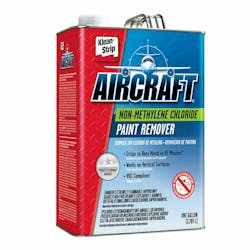If you haven’t needed to buy methylene chloride (also known as dichloromethane) paint stripper for a few months, you may be surprised to learn that the powerful stripper that starts to bubble old finishes within minutes is no longer available for sale to consumers. It’s long been scrutinized by the Environmental Protection Agency (EPA,) but starting Nov. 22, it became “unlawful for any person or retailer to sell or distribute paint removal products containing methylene chloride for consumer use, including e-commerce sales.”
But although the wording of the final rule, published March 27, indicated it was directed toward consumers and would exclude industrial and commercial uses, manufacturers of the smaller sizes commonly used by collision repair and restoration shops, such as gallons and quarts, seemingly decided just to halt production altogether instead of serving a limited market. (W.M. Barr, the manufacturer of several brands, including the popular Klean-Strip Aircraft Paint Remover, did not respond to ABRN’s requests for comment.) Methylene chloride is still available from at least one seller – Benco Sales, in Crossville, Tenn. – for industrial and commercial sales in larger quantities, such as 30 and 55-gallon drums.
In March, when the final rule was published, the EPA sought public comments on whether a training, certification, or limited-access program for commercial uses for methylene chloride could provide for its safe use in the workplace.
According to an EPA spokesperson who asked not to be identified, “EPA’s previous action was limited to methylene chloride in consumer paint and coating removal. The Agency is now taking a broader approach and evaluating more than 70 uses of methylene chloride, including commercial paint and coating removal. EPA will complete the public comment and scientific peer review process on the risk evaluation of these other methylene chloride uses, including commercial paint and coating removal, by June 2020. EPA then has two years to finalize regulations to address identified unreasonable risks.
“EPA’s final risk management regulations could be completed sooner for certain methylene chloride uses, and they could take the form of labeling, notifications, restrictions, and even bans. For example, EPA will consider whether to further pursue a proposal for a training, certification and limited access program for methylene chloride paint and coating removal activities in commercial settings if that approach can mitigate unreasonable risks identified in EPA’s final risk evaluation. EPA could also choose other approaches to addressing unreasonable risks aside from or in conjunction with a safety program.”
Commenters’ opinions were mixed, but many stated it could not be safely used in the workplace. Stephen A. Frangos, MD, MPH, who is president of the American College of Occupational and Environmental Medicine, pointed out that OSHA already requires training and a supplied-air respirator for even the lowest exposure of 25 parts per million up to 625 parts per million, and that has not been enough to prevent worker deaths.
“EPA has provided no proof that their proposed training and certification requirements will be any more effective,” he wrote. “It is our opinion, based on our expertise, experience, and review of the scientific literature, that training, certification and limited access of methylene chloride-containing products for commercial use will not provide enough safeguards to workers, and would present an unreasonable risk of serious illness and death.
“Methylene chloride (MC), also termed dichloromethane (DCM), is a highly volatile solvent, is heavier than air, and will accumulate in any container, such as tanks, mixing vessels and bathtubs,” he continued. “MC is easily absorbed through both the skin and lungs. MC travels throughout the body and crosses the blood-brain barrier. A portion of MC is metabolized to carbon monoxide. Health effects include ‘narcosis’ with symptoms of headache, lightheadedness and nausea. As exposure levels increase, MC will depress respirations, resulting in unconsciousness and ultimately death...with chronic exposure, MC has been deemed a probable carcinogen by both the EPA and the International Agency for Research on Cancer.”
Ban was a long time coming
ABRN readers may recall that methylene chloride paint stripper was a concern of the revised National Emission Standards for Hazardous Air Pollutants (NESHAP), Subpart HHHHHH rule, which became effective Jan. 2010, and for which facilities needed to show compliance by Jan. 2011. In addition to regulating surface coating operations, it encouraged a reduction in methylene chloride use and emissions, including evaluating whether it was possible to re-coat without stripping or identify potential alternative stripping methods (including sanding or media-blasting. One option for restoration shops, which would tend to strip complete bodies and panels, is to use equipment from Dustless Blasting. That process combines a media - usually crushed glass – with water and a corrosion inhibitor to quickly remove finishes to bare metal.)
Then in 2012, the Centers for Disease Control investigated the deaths of 13 bathtub refinishers in 10 states from 2000 to 2011 and determined they had used methylene chloride in confined spaces, combined with poor ventilation and insufficient respiratory protection, causing it to issue a warning against such use. Paint-remover manufacturers responded by also including warnings on the label. Public awareness of such dangers led to an outcry, and mass merchandisers began pulling it from their shelves in 2018.
The EPA performed a risk evaluation of methylene chloride under the Toxic Substances Control Act (TSCA.) Results of that evaluation could have led the EPA to either declare those chemicals safe for current uses; or it could ban, restrict, or require labeling of the chemicals. The EPA concluded in the March 2019 final rule that the use of methylene chloride for paint and coating removal “presents an unreasonable risk of injury to health due to human lethality.” However, it did not yet reach the same conclusion for commercial paint and coating removal.
‘Green’ formulas are available
The methylene chloride paint stripper probably most familiar to collision repair and restoration shops was the Klean-Strip Aircraft Paint Remover we previously mentioned, manufactured by W.M. Barr & Co. It now manufactures a non-methylene chloride formula stripper, which features a label that is mostly familiar, save for a green stripe that denotes it is the new formula.
The health benefits of eliminating methylene chloride don’t come without drawbacks, however. The old product promised to strip multiple layers in as little as five minutes, while the “new” product (introduced about five years ago) advises it will “strip to bare metal” in 45 minutes. The company also advises to first abrade the surface to increase its absorption and speed removal time.
The new formula is also flammable. In an ironic twist, William M. Barr founded his company in 1946 with only one product, the original methylene chloride Klean-Strip paint remover. It was a popular seller in the marketplace, positioned as a safer alternative to competitors’ flammable paint removers.
About the Author
Jay Sicht
Editor-in-Chief, FenderBender and ABRN
Jay Sicht is editor-in-chief of FenderBender and ABRN. He has worked in the automotive aftermarket for more than 29 years, including in a number of sales and technical support roles in paint/parts distribution and service/repair. He has a bachelor's degree in journalism from the University of Central Missouri with a minor in aviation, and as a writer and editor, he has covered all segments of the automotive aftermarket for more than 20 of those years, including formerly serving as editor-in-chief of Motor Age and Aftermarket Business World. Connect with him on LinkedIn.
Don't miss Jay's next article or podcast. Sign up for FenderBender Today's Collision Repair News and ABRN eNews here.

